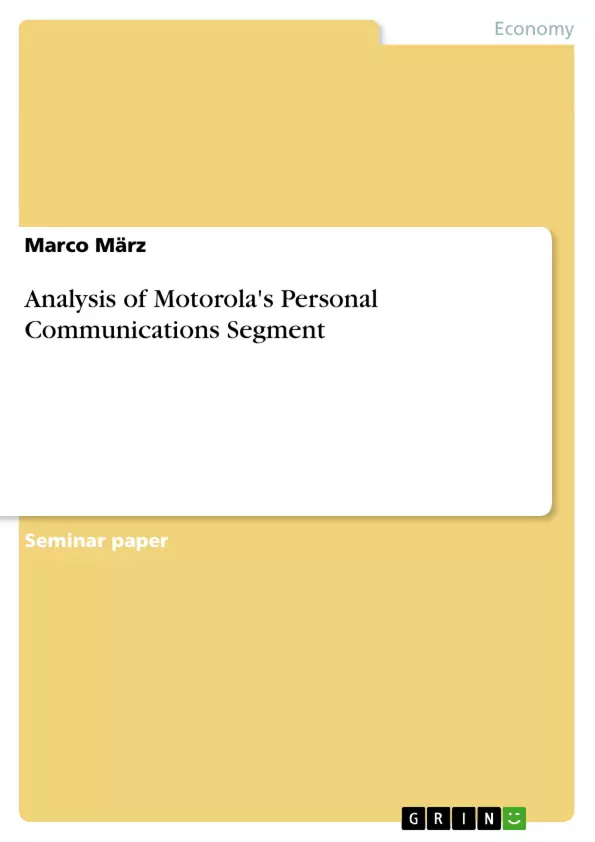In 1928 Paul Galvin founded the company as the “Galvin Manufacturing Corporation” in Chicago, Illinois. The first product launch, called a “battery eliminator” allowed radio consumers to operate directly from household current instead of the batteries supplied with earlier models. But the company’s name was soon displaced through its main product, “Motorola” radios, figurehead that conjures up the historical symbiosis of a mobile radio and a car (Agar, 2003). Under the leadership of Paul Galvin, Motorola became leader in military, space and commercial communications, grew as a manufacturer of consumer electronics and built its first semiconductor facility. The company founder died in 1959. As his successor Robert W. Galvin, P. Galvin’s son, was introduced. Within his leadership Motorola expanded into the international markets, and their object of view was shifted away from consumer electronics. As a fact of this challenge, the colour-TV receiver business was sold in the mid 70’s, so that they could concentrate their abilities on high-technology markets in commercial, industrial and government fields. With the 80’s ending, Motorola had become the doyen supplier of cellular phones. (www.motorola.com) You could say, that Motorola, Inc. is a global provider of wireless, broadband, automotive communications technologies and embedded electronic products. Further on the company provides software-enhanced wireless telephone and messaging, two-way radio products and systems, as well as networking and Internet-access products, for consumers, network operators and commercial, government and industrial customers. Motorola also provides end-to-end systems for the delivery of interactive digital video, voice and high-speed data solutions for broadband operators, and embedded semiconductor solutions for customers in wireless communications, networking and transportation markets. In addition, the company offers integrated electronic systems for the automotive, telematics, industrial, telecommunications, computing and portable energy systems markets. The last reported count of employees was 88.000. (www.yahoo.com) In most parts of my strategic analysis, I will focus on the Personal Communications Segment (PCS) of Motorola, the business group of Motorola’s cellular phones. Following Nokia, Motorola is the 2nd largest mobile phone producer worldwide.
Inhaltsverzeichnis (Table of Contents)
- Introduction
- An analysis of the relevant business environment of Motorola and its major competitors
- Industry Environment-PEST-Analysis
- Key factors for success and market structure
- Position of major competitors
- Nokia
- Samsung Electronics
- Siemens
- Opportunities and Threats
- Opportunities
- Threats
- Analysis of Motorola's internal environment
- The value chain analysis
- Marketing
- Production
- Research and Development
- Financial Resources
- Human Resources
- Strengths and Weaknesses
- Strengths
- Weaknesses
- The value chain analysis
- Assessment of Motorola's performance in terms of efficiency, effectiveness and return to investors
- The Balanced Scorecard
- The customer perspective
- The internal business process perspective
- The learning and growth perspective
- The financial perspective
- The Balanced Scorecard
- A review of the options available to Motorola's PCS and recommendations for future strategic direction
- Analysis of strategic options
- Ansoff's options matrix
- Existing Products
- New Products
- Market Penetration
- Product Development
- New
- Ansoff's options matrix
- Recommendations for future strategies
- Analysis of strategic options
- Recommendations for structures, systems and policies to implement these strategies successfully
Zielsetzung und Themenschwerpunkte (Objectives and Key Themes)
This report aims to analyze Motorola's competitive position within the global mobile phone market. It explores the company's internal and external environment, examining strengths, weaknesses, opportunities, and threats. The report also includes a strategic analysis of Motorola's Personal Communications Segment (PCS) and provides recommendations for future strategic direction.- Analyzing Motorola's position within the global mobile phone market
- Examining Motorola's strengths, weaknesses, opportunities, and threats
- Evaluating the company's internal and external environment
- Developing recommendations for future strategic direction
- Analyzing Motorola's Personal Communications Segment (PCS)
Zusammenfassung der Kapitel (Chapter Summaries)
- The Introduction provides a brief overview of Motorola's history and its current position as a global provider of wireless, broadband, and automotive communications technologies. It highlights the company's focus on the Personal Communications Segment (PCS) and its ranking as the second largest mobile phone producer worldwide.
- The next chapter delves into an analysis of the relevant business environment of Motorola and its major competitors. It utilizes a PEST-Analysis to examine the political, economic, social, and technological factors influencing the company's PCS. Specifically, it focuses on the United States and China, considering aspects such as government regulations, economic growth, and consumer demand.
- Moving into the analysis of Motorola's internal environment, the report examines the company's value chain, highlighting areas like marketing, production, research and development, financial resources, and human resources. This chapter also identifies the company's strengths and weaknesses.
- The following section assesses Motorola's performance in terms of efficiency, effectiveness, and return to investors. It employs the Balanced Scorecard framework to analyze the company's performance from various perspectives, including customer satisfaction, internal processes, learning and growth, and financial performance.
- The penultimate chapter reviews the strategic options available to Motorola's PCS and presents recommendations for future strategic direction. It leverages Ansoff's options matrix to explore potential strategies, such as market penetration, product development, and new market development.
Schlüsselwörter (Keywords)
The report focuses on the key concepts of strategic analysis, competitive advantage, PEST-analysis, value chain analysis, balanced scorecard, Ansoff's options matrix, global mobile phone market, Motorola, PCS, and future strategic direction. It investigates the competitive dynamics within the mobile phone industry, examining key factors such as government regulations, economic growth, consumer demand, and technological advancements. It aims to provide valuable insights into Motorola's current market position and potential strategies for future success.- Quote paper
- Marco März (Author), 2004, Analysis of Motorola's Personal Communications Segment, Munich, GRIN Verlag, https://www.grin.com/document/27493



